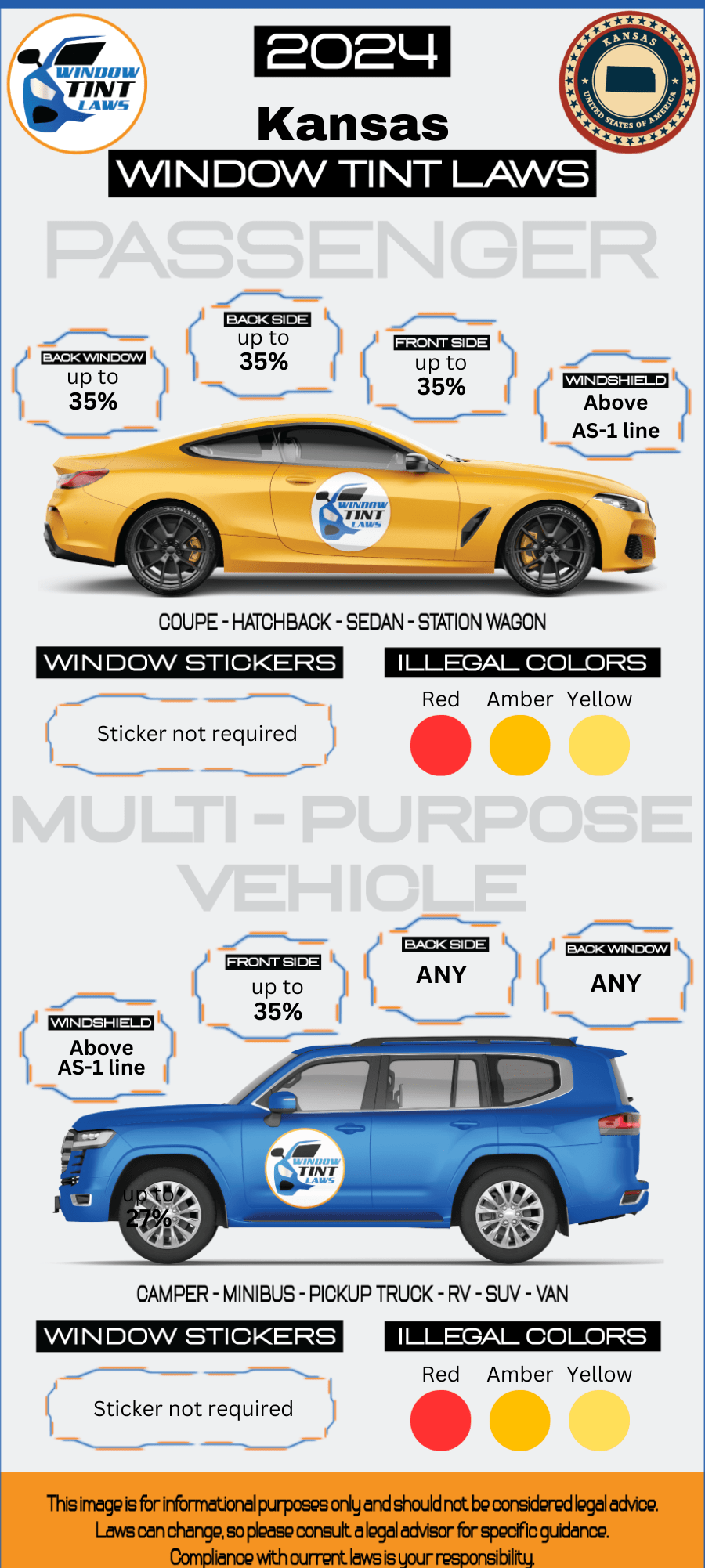

Article Created by Ryan Pietrzak
Last updated on February 5, 2024Kansas Tint Laws – 2024 Updated Legal Tint Limit
Please note that Kansas Tint Laws Regulation can change daily and may be interpreted differently at the city or county level. We recommend verifying this information with your local DMV or law enforcement agencies. We have manually fact-checked this content using official state resources. Kansas enacted tinting laws in 1997. If any information provided is incorrect or outdated, please contact us so we can make the necessary corrections. Thank you.
2024 Kansas Tint Laws – Legal Tint Limit For Passenger Vehicles
- Front Windshield: Non-reflective tint is allowed above the manufacturer’s AS-1 line.
- Front seat side windows: up to 35% tint darkness allowed
- Back seat side windows: up to 35% tint darkness allowed
- Rear window: up to 35% tint darkness allowed
2024 Kansas Tint Laws – Legal Tint Limit For Multi-Purpose Vehicles
- Front Windshield: Non-reflective tint is allowed above the manufacturer’s AS-1 line.
- Front seat side windows: up to 35% tint darkness allowed
- Back seat side windows: Any tint darkness can be used.
- Rear window: Any tint darkness can be used.

- Medical exemptions: Kansas tint laws permit darker tints on front side windows with a doctor’s note
- Kansas tint laws prohibit metallic or reflective tint on any of the windows
- Kansas tint laws are statewide with no additional local regulations
- Violating Kansas tint laws average cost of a ticket for a window tint violation is typically around $45. However, this amount can vary depending on the jurisdiction and specific circumstances of the violation. Repeat offenses may result in higher fines
What does VLT Mean according to Kansas Tint Laws?
- Window tint film’s light transmission is measured as VLT (Visible Light Transmission) and each state has its own legal limits for VLT on car windows.
- A HIGHER VLT means that more light is allowed to pass through the window tint film.
- Example: a 75% tint will allow 75% of the light to pass through whereas a 5% tint will only allow 5% of the light to pass through, making the 5% tint a much darker film.
- Kansas window tint laws has specific VLT limits for Passenger Vehicles and Multi-Purpose Vehicles.
FAQ’s Regarding Kansas Tint Laws and Kansas Legal Tint Limit
What is the darkest legal tint in Kansas?
According to Kansas tint laws the darkest legal window tint is 35% VLT (Visible Light Transmission) for all side and rear windows of passenger vehicles. This means the tint must allow at least 35% of the light to pass through.
Are police exempt from window tint laws in Kansas?
Yes, in Kansas, police vehicles are typically exempt from the state’s window tint laws. This exemption allows law enforcement vehicles to use window tint that is darker than the legal limit for regular passenger vehicles.
How do I get a tint waiver in Kansas?
In Kansas, to obtain a window tint exemption for medical reasons, you must submit a completed physician’s statement indicating the medical necessity for darker tint to the Kansas Department of Revenue. If approved, this exemption allows for window tint that is darker than the standard legal limits.
How much is a tint ticket in Kansas?
According to Kansas tint laws, the cost of a ticket for a window tint violation is typically around $45. However, the exact amount may vary based on the local jurisdiction and the specific circumstances of the violation.
Can you get pulled over for tint in Kansas?
Yes, in Kansas, you can be pulled over by law enforcement if your vehicle’s window tint is suspected to be darker than the state’s legal limit. This could lead to a ticket or a requirement to remove the non-compliant tint.
How to get a Tint Exemption in Kansas
The State of Kansas does not currently allow for window tint medical exemptions that would allow you to tint your windows darker for medical purposes. If you would like to file a petition with the State in order to appeal this and request that they change the law we suggest you contact the Kansas State Representative directly.

Ryan Pietrzak
Creator of Windowtintlaws.us
